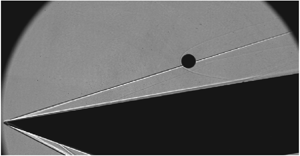Article contents
Dynamics of a spherical body shedding from a hypersonic ramp. Part 2. Viscous flow
Published online by Cambridge University Press: 16 November 2020
Abstract

The separation dynamics of a sphere released from the surface of a ramp into a hypersonic flow is investigated, focusing on the influence of the ramp boundary layer on the sphere behaviour. First, numerical simulations are conducted of a sphere interacting with an isolated high-speed boundary layer to determine the influence on the sphere force coefficients as the sphere diameter and wall-normal location are varied. It is found that the lift coefficient is strongly affected by the near-wall interactions, becoming increasingly negative as the ratio of the sphere radius to boundary-layer thickness,  $r/\delta$, is decreased. These results are combined with force coefficients derived from simulations of the sphere interacting with the ramp-generated oblique shock to enable numerical predictions of the sphere trajectories for a
$r/\delta$, is decreased. These results are combined with force coefficients derived from simulations of the sphere interacting with the ramp-generated oblique shock to enable numerical predictions of the sphere trajectories for a  $10^{\circ }$ ramp at Mach 6 (using a similar decoupled approach to Part 1 of this work). It is found that the three trajectory types of the inviscid situation – shock surfing, ejection followed by re-entrainment within the shock layer and direct entrainment – also characterize the sphere behaviour here. Their relative prevalence, however, is influenced by the sphere size: for smaller values of
$10^{\circ }$ ramp at Mach 6 (using a similar decoupled approach to Part 1 of this work). It is found that the three trajectory types of the inviscid situation – shock surfing, ejection followed by re-entrainment within the shock layer and direct entrainment – also characterize the sphere behaviour here. Their relative prevalence, however, is influenced by the sphere size: for smaller values of  $r/\delta$, direct entrainment dominates because of the wall suction, while shock surfing and then ejection/re-entrainment become increasingly likely at larger values of
$r/\delta$, direct entrainment dominates because of the wall suction, while shock surfing and then ejection/re-entrainment become increasingly likely at larger values of  $r/\delta$. Increasing the ramp angle and/or the free-stream Mach number reduces the relative influence of the boundary-layer interactions. Finally, experiments are conducted using free-flying spheres released from a ramp surface in a hypersonic shock tunnel, confirming the major trends predicted numerically.
$r/\delta$. Increasing the ramp angle and/or the free-stream Mach number reduces the relative influence of the boundary-layer interactions. Finally, experiments are conducted using free-flying spheres released from a ramp surface in a hypersonic shock tunnel, confirming the major trends predicted numerically.
JFM classification
Information
- Type
- JFM Papers
- Information
- Copyright
- © The Author(s), 2020. Published by Cambridge University Press
References
REFERENCES
Butler et al. supplementary movie 1
Experimental shadowgraph movie of a 3.18-mm diameter sphere: x0/r=3.9, r/δ=5.6.
Butler et al. supplementary movie 2
Experimental shadowgraph movie of a 3.18-mm diameter sphere: x0/r=7.2, r/δ=3.9.
- 9
- Cited by


